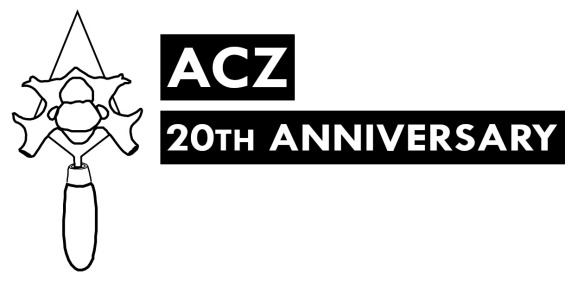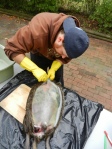Doug’s Archaeology is at it again, with a one-month blog carnival! Expanding on a survey of archaeologists done a few years ago (see article here), Doug asks us: What are the grand challenges facing YOUR archaeology? He gives us leave to decide how we want to define “our” archaeology.
My archaeology occurs in the Arctic. In my mind, the biggest current and continuing challenge of archaeology is climate change.
This is a topic that is (finally) starting to get more attention from the greater community of professionals, scientists, and funding agencies. Although warming temperatures have allowed for some amazing finds via surveys of melting ice patches (for example, see this article), the negative effects of climate change on archaeological sites in the Arctic far outweigh the good. These effects come in the form of coastal erosion due increasing storm severity, deterioration thanks to The Great Unthaw of permafrost, flooding from increased precipitation, etc. This has been addressed on other blogs, such as Anne Jensen’s Out of Ice and Time (here) and Shelby Anderson’s blog (here). And publications discussing the issue include Hans Blankholm’s 2009 article on research and CRM strategies in response to climate change in Arctic, Subarctic, and Subantarctic regions; Pauline Goetz’ 2010 MA Thesis, Preserving Arctic Archaeology in the 21st Century: Threats of Climate Change; Kieran Westley et al’s 2011 article on impact of sea level change on coastal sites in Newfoundland; and Max Friesen et al’s 2015 report on their Arctic Cultural Heritage at Risk (Arctic CHAR) project.
Even though it’s coastal erosion we have to thank for the discovery of Zhenya the 45,000 year old butchered Siberian mammoth, I shudder to think how many comparable sites and specimens from coasts across the Arctic have already been lost. Sites across the circumpolar Arctic are being actively destroyed by climate change, such as Ukkuqsi (see here for a video of active erosion at this site), Walakpa, and Nunalleq.
Federal agencies are only just beginning to respond to the ever-growing threat to these irreplaceable cultural resources. The National Park Service is sponsoring projects like the Climate Change and Archaeology in Northwest Alaska: Nuluk Study (you can read a brief overview here), and the U. S. Army Corps of Engineers – Alaska District put out a study titled “Archaeological Survey of the Mid-Beaufort Sea Coast: An Examination of the Impacts of Coastal Changes on Cultural Resources” in 2012. Thankfully, the National Science Foundation’s Arctic Social Sciences program is starting to fund a growing number of projects at sites under threat from climate change through their small “RAPID” grant, such as the “Emergency Excavation of Eroding Structure, Walakpa, Alaska” (here) and “Mitigation of Threatened Cultural Resources at the Shaktoolik Airport Site” (here).

Eroding House at Walakpa – Photo by Dr. Anne Jensen
—————————-
My archaeology also occurs in the exalted (and white-washed) halls of academia. As a PhD student, it seems like the biggest challenge facing new archaeologists is that of finding employment upon graduation, especially if they wish to remain in academia. Many of my friends, now members of the vaunted “Doctor” crowd, are working as Adjunct Professors at community colleges for little money, no benefits, and no job security. At one such Anthropology Department, the adjuncts outnumber the full-time professors 3:1. (For an eye-opening look at the plight of adjuncts, read this and this).
In 2010, The Economist wrote about the growing oversupply of PhDs, and Nature offered a more global view on what they called the PhD Factory in 2011. Multiple books have been published on the subject, with reassuring titles like “A Degree of Futility,” “The Graduate School Mess,” and “Moving On: Essays on the Aftermath of Leaving Academia.” Matthew Wolf-Meyer described the Bureau of Labor Statistics’ take on the future of anthropology and archaeology jobs in a great blog post in 2013, and in 2014 anthropologist Ryan Anderson wrote an entertaining (and depressing) blog post about Academia and the people without jobs that I highly recommend
According the the Bureau of Labor Statistics’ 2014 data (which doesn’t include 13 states), there are 7,040 anthropologists/archaeologists in non-academic positions, and 6,100 anthropologists/archaeologists in academic jobs. They predict that “prospective anthropologists and archeologists will likely face strong competition for jobs because of the small number of positions relative to applicants.” The National Science Foundation reported that 527 Anthropology PhDs were awarded in 2014. According to their data, only 44.8% had “job commitments” upon graduation – and 40.3% of those were in the form of postdocs.
There is a reason that hashtags like #FastForFaculty, #AltAc, and #GradSchoolProblems have gained popularity. Graduate school is difficult enough without worrying about the vanishingly small number of permanent academic positions available after all that hard work and emotional trauma. The Academic Fight Club mentality is as applicable to Anthropology as it is to STEM disciplines.
After obtaining an MA at one institution and completing almost four years of a PhD program at another, I have decided that the joy of teaching students is not worth the stress (and destitution) associated with an adjunct or postdoc position. Although I plan on eventually finishing my dissertation, I will be happily running back to a permanent job in federal CRM this March!
I encourage you to check out all of the other blogs that are participating in the Grand Challenge Blog Carnival, and to participate yourself if you are interested. Also, if you’re on Twitter please use #blogarch when discussing the blog carnival or blogging session!






